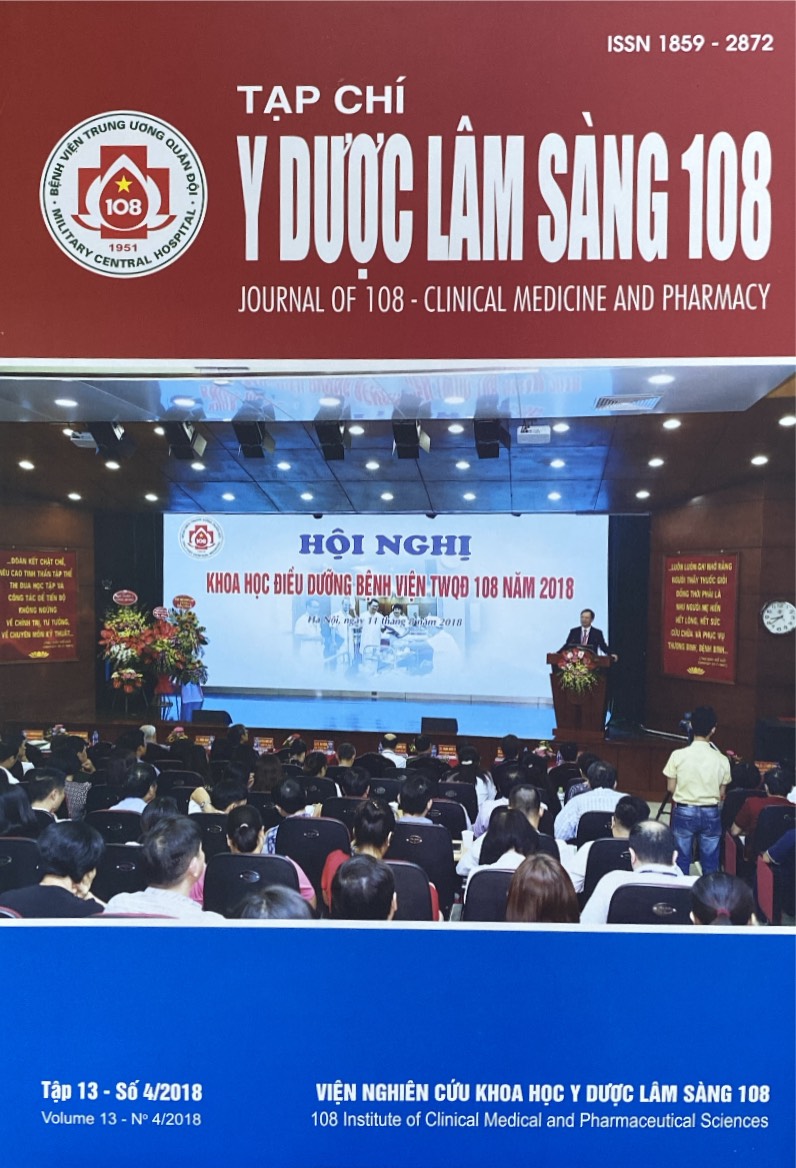Một số đặc điểm lâm sàng, hình ảnh cộng hưởng từ não và mối liên quan giữa tổn thương bó tháp với mức độ rối loạn chức năng vận động thô ở trẻ bại não thể co cứng
Main Article Content
Keywords
Tóm tắt
Mục tiêu: Mô tả một số đặc điểm lâm sàng, hình ảnh cộng hưởng từ não và đánh giá mối liên quan giữa tổn thương bó tháp với mức độ rối loạn chức năng vận động thô (GMFCS) ở trẻ bại não thể co cứng. Đối tượng và phương pháp: Mô tả cắt ngang. Tất cả các trẻ bại não thể co cứng từ 2 tuổi đến 12 tuổi điều trị tại Khoa Phục hồi Chức năng - Bệnh viện Nhi Trung ương trong thời gian từ tháng 12/2015 đến tháng 8/2017 đủ tiêu chuẩn được đưa vào nghiên cứu. Các trẻ tham gia nghiên cứu được đánh giá lâm sàng, mức độ rối loạn chức năng vận động thô, chụp cộng hưởng từ não thông thường và bó tháp. Kết quả: 44 trẻ bại não thể co cứng (tuổi trung bình 4,5 ± 2,1 tuổi): 22 (50,0%) trẻ liệt cứng tứ chi, 15 (34,1%) trẻ liệt cứng hai chi dưới và 7 (15,9%) trẻ liệt cứng nửa người. 25 (56,8%) trẻ bại não có mức độ rối loạn chức năng vận động thô độ II, 13 (29,8%) trẻ mức độ rối loạn chức năng vận động thô độ III và 6 (13,6%) trẻ mức độ rối loạn chức năng vận động thô độ IV. 33 (75%) trẻ bại não thể co cứng có bất thường cấu trúc não trên cộng hưởng từ thông thường, tổn thương chất trắng quanh não thất có tỷ lệ cao nhất chiếm 61,4%. DTI bó tháp của 44 trẻ bại não thể co cứng cho thấy giá trị trung bình FA < 0,50. Có mối liên quan nghịch chiều giữa giá trị FN, FA với mức độ rối loạn chức năng vận động thô ở cả bó tháp *phải và **trái (*r = -0,618, **r = -0,446, p<0,001), (*r = -0,492, **r = -0,529, p<0,001). Sự thay đổi giá trị ADC của bó tháp có liên quan chặt chẽ với sự thay đổi mức độ GMFCS (*r = 0,514, **r = 0,725, p<0,001). Kết luận: Liệt tứ chi là thể lâm sàng chủ yếu, gây ra rối loạn vận động thô nặng (mức độ rối loạn chức năng vận động thô độ III - IV). Tổn thương của bó tháp có liên quan chặt chẽ với mức độ rối loạn chức năng vận động thô ở trẻ bại não thể co cứng (p<0,001).
Article Details
Các tài liệu tham khảo
2. Bax M, Tydeman C, Flodmark O (2006) Clinical and MRI correlates of cerebral palsy: The European Cerebral Palsy Study. Jama 296(13): 1602-1608.
3. Krageloh-Mann I, Horber V (2007) The role of magnetic resonance imaging in elucidating the pathogenesis of cerebral palsy: A systematic review. Dev Med Child Neurol 49(2): 144-151.
4. Cascio CJ, Gerig G, Piven J (2007) Diffusion tensor imaging: Application to the study of the developing brain. J Am Acad Child Adolesc Psychiatry 46(2): 213-223.
5. Palisano R et al (1997) Development and reliability of a system to classify gross motor function in children with cerebral palsy. Dev Med Child Neurol 39(4): 214-23.
6. Howard J et al (2005) Cerebral palsy in Victoria: motor types, topography and gross motor function. J Paediatr Child Health 41(9-10): 479-483.
7. Back SA et al (2001) Late oligodendrocyte progenitors coincide with the developmental window of vulnerability for human perinatal white matter injury. J Neurosci 21(4): 1302-1312.
8. Reid SM et al (2015) Relationship between characteristics on magnetic resonance imaging and motor outcomes in children with cerebral palsy and white matter injury. Research in Developmental Disabilities 45-46: 178-187.
9. Nguyễn Văn Tùng, Lâm Khánh, Cao Minh Châu, Trịnh Quang Dũng và cộng sự (2017) Những tiến bộ mới trong đánh giá chức năng thần kinh trẻ em bằng MRI não sức căng khuếch tán. Tạp chí Nghiên cứu Y học, 108(3), tr. 148-149.
10. Yoshida S et al (2010) Quantitative diffusion tensor tractography of the motor and sensory tract in children with cerebral palsy. Dev Med Child Neurol 52(10): 935-940.
11. Scheck SM, Boyd RN, Rose SE (2012) New insights into the pathology of white matter tracts in cerebral palsy from diffusion magnetic resonance imaging: Asystematic review. Dev Med Child Neurol 54(8): 684-696.
12. Chang MC et al (2014) Diffusion tensor imaging demonstrated radiologic differences between diplegic and quadriplegic cerebral palsy. Neurosci Lett 512(1): 53-58.
 ISSN: 1859 - 2872
ISSN: 1859 - 2872
